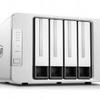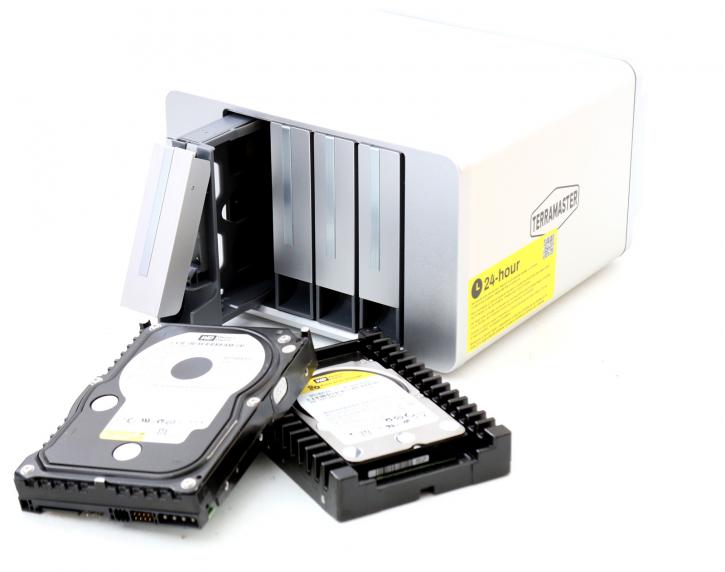Final Words & Conclusion
Conclusion
This particular NAS from TerraMaster offers good value for your money. This 4+2 bay network-attached storage (NAS) drive has many business-friendly features, including a quick 2.5 GbE LAN interface, link aggregation, and many RAID configuration choices. The NAS has a robust SoC, 4GB of RAM, and an extra 10 Gbit/sec interface. Consequently, it is future-proof and DDR4 SODIMM upgradable towards a whopping 32 GB. Today, the hardware of a NAS system is no longer the most important factor to consider. According to our observations, TOS (the NAS operating software) has significantly improved over previous generations but still lacks diversity compared to tier-1 brands.
SSDs or HDDs?
SSD prices continue to stabilize, and they are currently as cheap as 10 cents per GB. Suppose you do not want large volume sizes. In that case, I would choose SSDs, not only for durability and the elimination of mechanical moving parts but also because these devices use far less power and will save you energy and thus money. Remember, this hardware is active 24/7 all year round. You should constantly remember that a NAS is likely to be on all the time. TLC and QLC NAND-based SSDs are ideal for NAS storage since it is typically cold data, which means it will remain there for a long period without dramatically overwriting important NAND cell cycles. I'll show this again, energy prices have risen, say 35 Cents per KWh in EUR/USD.
- If you keep adding HDDs at 8 Watt per HDD that's 31 EUR per year for each HDD.
- If you keep adding SSDs at 1-2 Watt per SSD that's 3 to 6 EUR per year for each SSD.
Hardware
The Intel Quad-Core 10 nm Celeron N5105 CPU (Jasper Lake) quad-core CPU can turbo to a 2.9 GHz Turbo clock frequency, deliver plenty of performance and easily cope with the performance 2.5 Gbps jacks. The 4GB memory is also a sweet spot but is upgradeable to 8GB and 16GB in dual-channel or even 2x 16GB. But again, that software stack is just incredibly efficient with memory.
We like that we can add 4x HDD or SSDs to the unit; the tray caddies take both. We do like the two NVME M.2. slots. We're at a clipping point where NVMe storage is getting cheaper than SATA3 SSDs (I know, weird, right?). It will be interesting to see what the future brings, as I can imagine NVMe M. 2-based NAS units solely for best performance and value. I have to say, though, that we love M.2. NVMe units; you can use them as SSD cache or just as the main volume cluster. Concerning all that, we feel the one gripe this NAS unit has is the 2.5 GigE connections; 5 GigE or 10 GigE, of course, is a better match for such fast M2 Units.
Pricing
When writing, the four-bay variant with a quad-core processor, 4GB of RAM, two NVMe M.2 drive slots, and twin 2.5 Gbps connectors was $499. For a customer, it is a noteworthy amount of money to spend for any SOHO/business. However, from where I sit, it is well worth the money. Of course, the additional expenditures for HDD/SSDs must be taken into consideration also. If you wish to make your LAN infrastructure multi-GigE compliant, you'll need a 2.5/5/10 Gbps switch. However, in the long run, it is an investment that will continue for many years. If not all, motherboards already feature an Intel/Marvell/Aquantia/Realtek 2.5, 5, or 10 Gbps Ethernet connector, reducing the extra expense of a 10 Gbps Ethernet NIC on the client-side.
Energy Efficiency
In a single SSD/HDD setup, the NAS uses about 15 Watts of power, which is good for a NAS that can last this long. The Celeron (Jasper Lake) quad-core CPU is a nice match for the environment; that chip alone uses 10 Watts of power at full load. When you add in your SSDs or HDDs, you will have a pretty good idea of how much power your computer uses. If you don't use your hard drives for, say, 30 minutes (or however long you set the sleep time to be), they will go into sleep mode and not use a lot of extra power. The unit also has a hibernation mode. When in hibernation, the unit goes to sleep and uses less than one watt of power. To wake it up, you can press a button or use a WOL app on your smartphone. This means that you can wake up the unit from outside your network. This is very helpful if you are traveling and don't want your NAS to be on all the time. NAS units in general use very little energy; it's the storage and how you use it that is responsible for the rest. Especially HDDS can use of a lot of energy when powered on and active 24/7/365.
Final Words
The TerraMaster F4-423 offers fair value for money, mainly due to performance and storage slots. You can mount 4x SATA3 SSD/HDDs and two NVMe M.2. SSDs. The latter can be set up as a cache and function as your primary or secondary storage arrays. NVMe is super fast, so it's a bit of a bummer that the ethernet jacks aren't any faster than 2.5 Gbps. This SSD can utilize up to 32GB RAM in dual channel (4GB default single SODIMM DDR4), bringing in a lot of additional value. TerraMaster is a bit of an underdog in the industry, and that shows in pricing. Despite this, the TerraMaster F4-423 4+2 Bay 2.5 GbE NAS leaves us with an overall excellent impression. You get quite a bit for your money. The software package is maybe a touch on the timid side. The TerraMaster F4-423 is available for $499 at the time of our study, nearly $100 less costly than the alternatives we examined. Its capabilities are adequate to meet a variety of needs. We like the ability to install extra RAM (up to 32GB). The performance was generally fine; the throughput is close to 300 MB/sec. In addition to enabling hardware encryption for stored information and 4K video transcoding for media files, PLEX support, etc., the CPU provides advantageous capabilities for professionals and non-professionals. RAID is still a wonderful feature, particularly when paired with a spare drive that may be set up with a 4-bay NAS as a hot spare. TerraMaster is continually enhancing the operating system, as proven by the release of yet another substantial upgrade. The NAS is one of the quickest and most cheaply priced devices we have evaluated. Undeniably recommended that your workload is stricktly NAS (file) related. For broader and more diverse application support, you'd be steered to another brand(s).
- Sign up to receive a notification when we publish a new article
- Or go back to Guru3D's front page.


